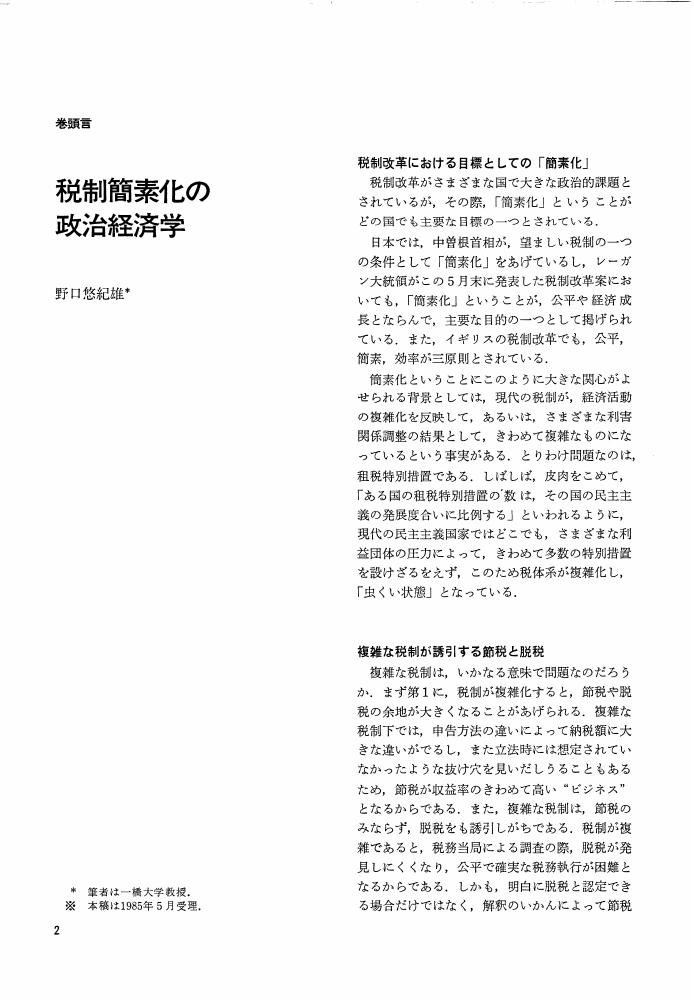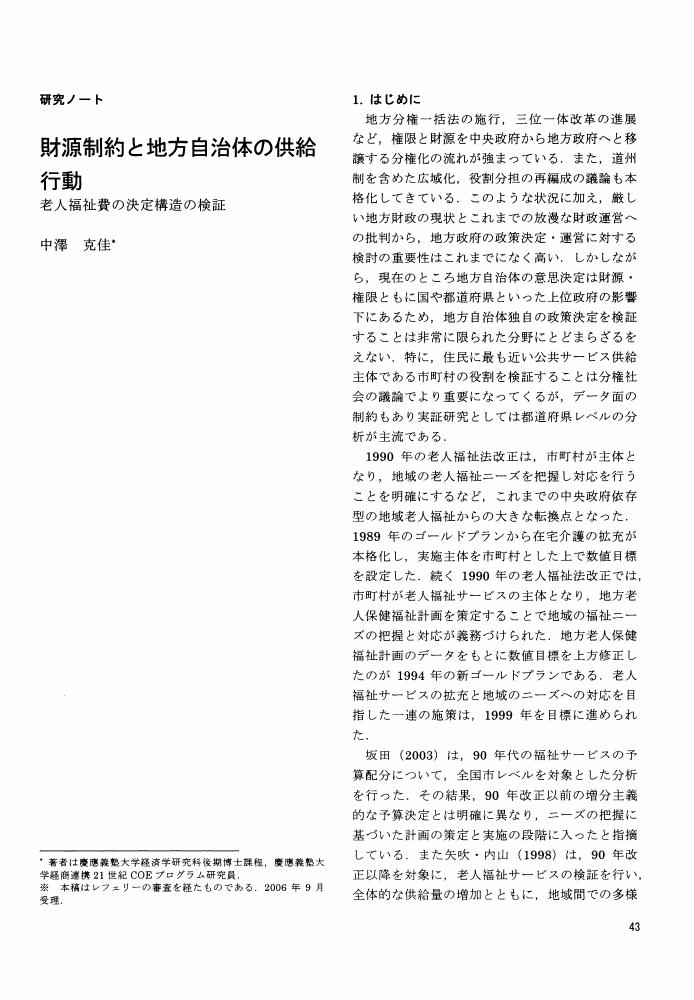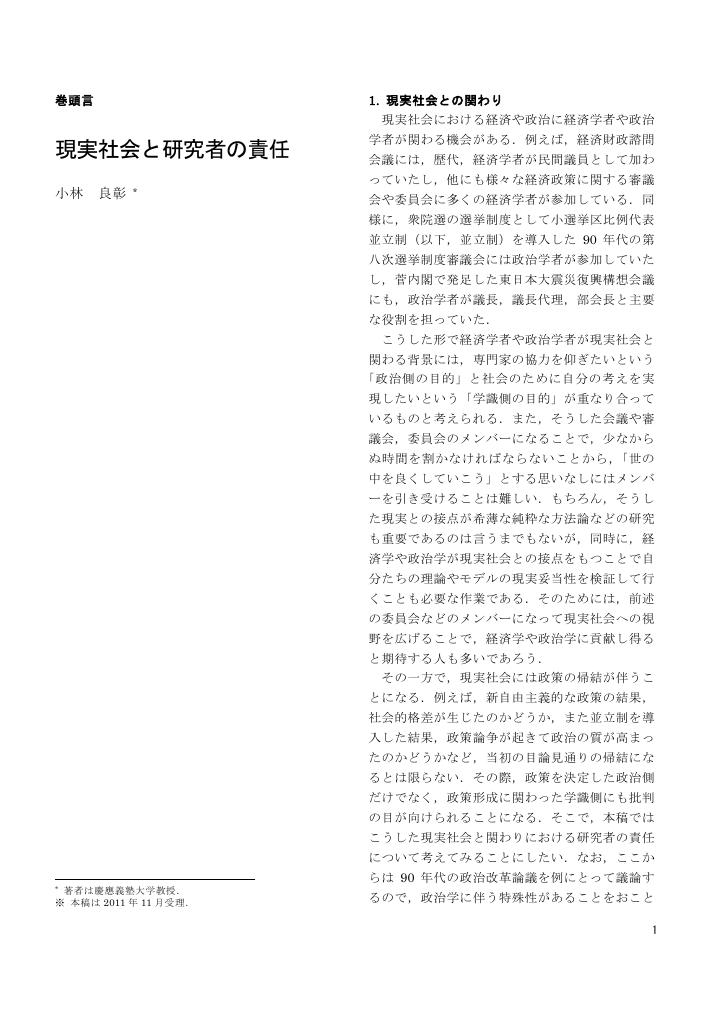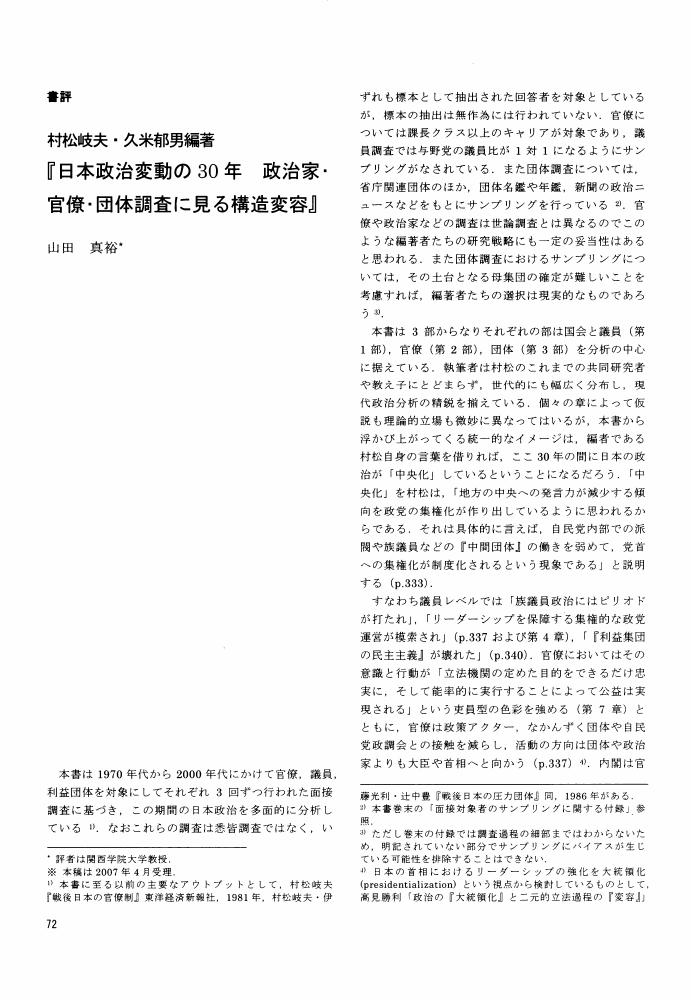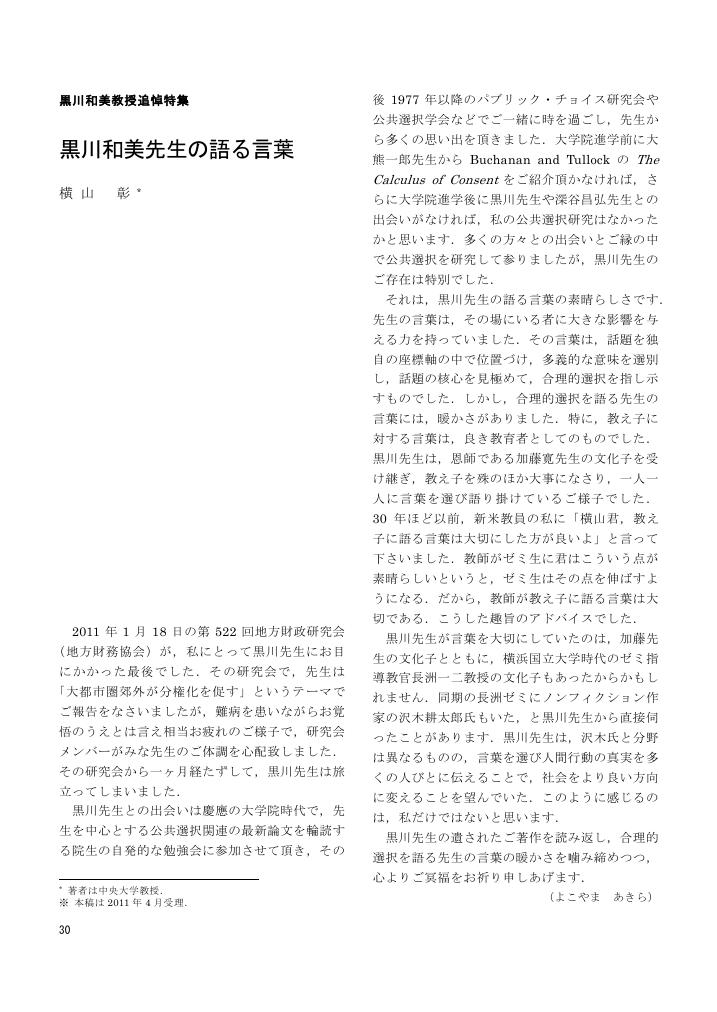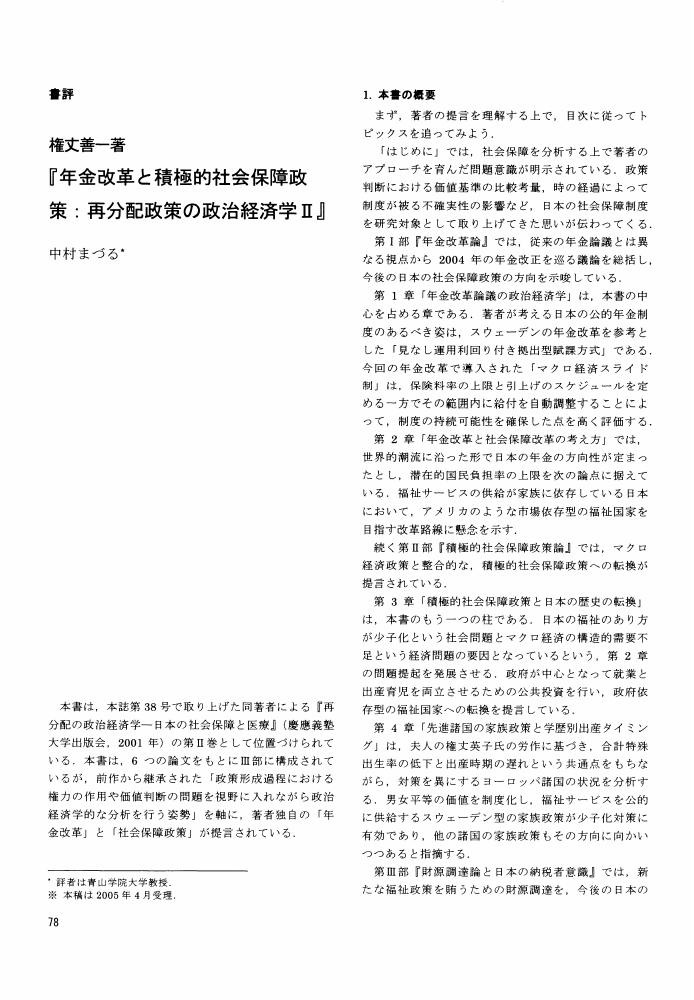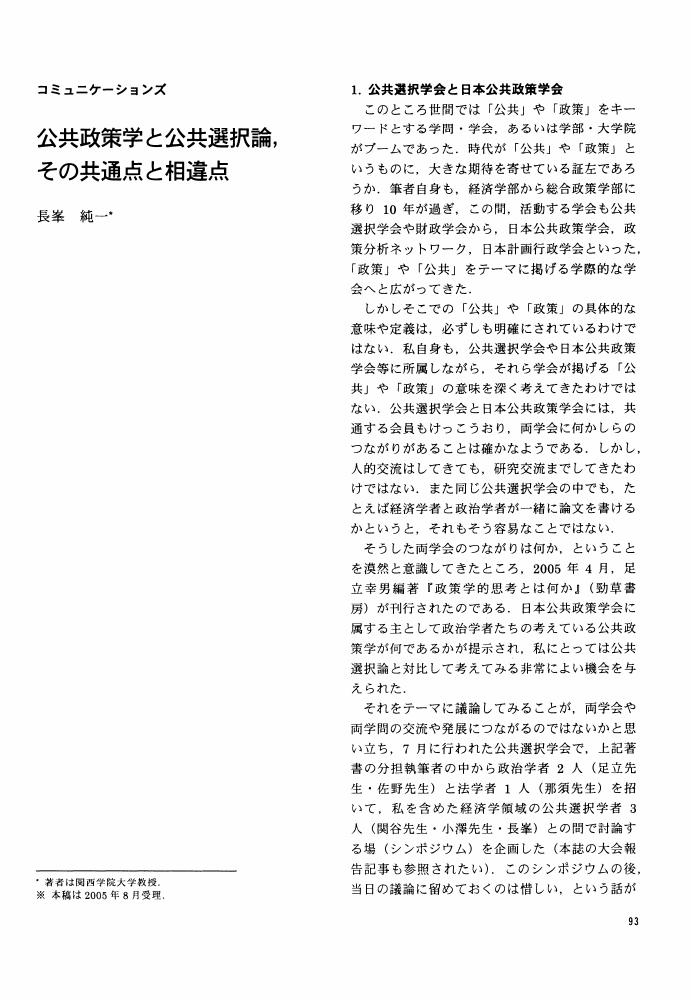82 0 0 0 OA 特別交付税における官僚の影響に関する分析*
- 著者
- 湯之上 英雄
- 出版者
- 公共選択学会
- 雑誌
- 公共選択の研究 (ISSN:02869624)
- 巻号頁・発行日
- vol.2005, no.45, pp.24-44, 2005-12-05 (Released:2010-10-14)
- 参考文献数
- 16
Recently Japanese government carries out the structural reforms on relation between central and local government. The reconsideration of local allocation tax grants is one of the most important themes in Japan.Local allocation tax grants, which contain“ordinary local allocation tax grants”and“special local allocation tax grants”, are required to operate objectively. Ordinary local allocation tax grants have rigorous formula of determining the amount of grants, so it is considered that there are no interventions from any participant, such as politicians or bureaucrats.However when it comes to special local allocation tax grants, there has less rigorous formu-las than ordinary grants, it is wondered that bureaucrats are able to control the amount of the grants.First, we construct a theoretical model which describes the bureaucrat's behavior. There are two type bureaucrats, incumbent and retiree, who are over lapped in the economy. We show that both incumbent and retired bureaucrats choose a trigger strategy which supports positive transfers from incumbent bureaucrats to their seniors.Second we estimate the regression model that formulates the structure of grants. The empirical results support our theoretical model; there are positive transfers from present bureaucrats to senior ones who become now local governors. We also find the positive correlation between the grants and intergovernmental personnel exchanges. In other words the increase in the number of central government officers admitted to the local government leads to the increment of special local allocation tax grants. With using the estimators and explanatory variables, we calculate the amount of the influences of bureaucrats on special local allocation tax grants. It is estimated that about 50% of total amount of special local allocation tax grants are determined by influences of bureaucrats.
20 0 0 0 OA 行動経済学と神経経済学は標準的経済学を変えるのか
- 著者
- 瀧澤 弘和
- 出版者
- 公共選択学会
- 雑誌
- 公共選択の研究 (ISSN:02869624)
- 巻号頁・発行日
- vol.2010, no.54, pp.67-75, 2010-08-15 (Released:2013-07-31)
- 参考文献数
- 39
19 0 0 0 OA 税制簡素化の政治経済学
- 著者
- 野口 悠紀雄
- 出版者
- 公共選択学会
- 雑誌
- 公共選択の研究 (ISSN:02869624)
- 巻号頁・発行日
- vol.1985, no.5, pp.2-5, 1985-09-15 (Released:2010-10-14)
17 0 0 0 OA 所得格差,汚職,経済成長
- 著者
- 水野 伸宏
- 出版者
- 公共選択学会
- 雑誌
- 公共選択の研究 (ISSN:02869624)
- 巻号頁・発行日
- vol.2011, no.56, pp.48-52, 2011-07-15 (Released:2014-07-13)
- 参考文献数
- 10
15 0 0 0 OA 首相の辞任と支持率*
- 著者
- 増山 幹高
- 出版者
- 公共選択学会
- 雑誌
- 公共選択の研究 (ISSN:02869624)
- 巻号頁・発行日
- vol.2001, no.37, pp.14-24, 2001-12-15 (Released:2010-10-14)
- 参考文献数
- 37
In this study I try to understand how the approval rating of the Prime Minister affects the probability of his resignation. My analysis relies on the statistical technique of duration modeling, which can be used to explore the effects of independent variables on the occurrence and timing of an event of interest. By applying a discrete-time model on the data set of the postwar Japanese Prime Ministers, I show that the probability of the Prime Minister resigning not only increases over his term in office, but also depends on his ability to gain public support.
11 0 0 0 OA 財源制約と地方自治体の供給行動
- 著者
- 中澤 克佳
- 出版者
- 公共選択学会
- 雑誌
- 公共選択の研究 (ISSN:02869624)
- 巻号頁・発行日
- vol.2006, no.47, pp.43-54, 2007-01-15 (Released:2010-10-14)
- 参考文献数
- 20
11 0 0 0 OA 育児支援施策をめぐる自治体間財政競争
- 著者
- 田中 宏樹
- 出版者
- 公共選択学会
- 雑誌
- 公共選択の研究 (ISSN:02869624)
- 巻号頁・発行日
- vol.2009, no.52, pp.25-36, 2009-07-05 (Released:2013-03-22)
- 参考文献数
- 32
This paper focuses on an optimal provision of public services for child care, considering them as local public goods. According to the fiscal competition theory, policy competition among local governments may not induce an optimal provision of local public goods. On the basis of this theoretical consequence, it examines, using an empirical method, whether or not public services for child care of local governments deviate from a level of optimal provision.More specifically, I verify whether or not there exits strategic interaction on public expenses for child care among local governments, by using cross section data of Japanese prefectures and estimating linear reaction functions, based on the welfare competition model adopted by Wildasin (1991). From the positive analysis, it can be seen that there is “strategic complement" in the decisions making of local governments. I therefore point out that public expenses for child care can actually deviate from an optimal level.
9 0 0 0 OA 地方自治体における政権交代と財政規律*
- 著者
- 藤澤 昌利
- 出版者
- 公共選択学会
- 雑誌
- 公共選択の研究 (ISSN:02869624)
- 巻号頁・発行日
- vol.2004, no.42, pp.20-33, 2004-07-05 (Released:2010-10-14)
- 参考文献数
- 22
Reducing public debt is one of the most urgent issues for local governments in Japan. In this paper, I focus on the political aspect of this problem and examine the relationship between fiscal efficiency and gubernatorial turnover in local governments. The main purpose of this paper is to assess the governors' Moral Hazard problem called “Kenpu-Jyunen.” (An epigram: Over ten years of the same administration makes governments corrupt.)Using panel data of 47 prefectures from FY 1976 to FY 1999, I find U-shaped relationship between the governors' tenure of office and the increase of the net debt and/or the primary deficit. More specifically, as the governor's tenure lasts, its administration becomes more efficient for up to twelve years. However when he keeps in power beyond twelve years (over three times of reelections), harmful effects of reelection turn out and it becomes less efficient. In addition, we find administration becomes more efficient as the governor's age of inauguration is high, and as the prefectural assembly is more solid in supporting the governor.This finding suggests that administrative and fiscal discipline in local governments could not work well due to the Moral Hazard when long tenure weakens the pressure of gubernatorial turnover. In the trend toward the decentralization, governors' authority and responsibility are supposed to be intensified. Correspondingly, we should have more profound discussion on the introduction of governor's term limits as a rule of democracy.
6 0 0 0 OA 現実社会と研究者の責任
- 著者
- 小林 良彰
- 出版者
- 公共選択学会
- 雑誌
- 公共選択の研究 (ISSN:02869624)
- 巻号頁・発行日
- vol.2011, no.57, pp.1-3, 2011-02-15 (Released:2014-11-17)
- 著者
- 佐野 亘
- 出版者
- 公共選択学会
- 雑誌
- 公共選択の研究 (ISSN:02869624)
- 巻号頁・発行日
- vol.2009, no.53, pp.83-87, 2009-12-15 (Released:2013-06-28)
- 参考文献数
- 1
5 0 0 0 OA 集合行為と社会的規範の進化
- 著者
- エリノア オストロム 木村 久徳 中村 まづる
- 出版者
- 公共選択学会
- 雑誌
- 公共選択の研究 (ISSN:02869624)
- 巻号頁・発行日
- vol.2010, no.54, pp.3-19, 2010-08-15 (Released:2013-07-31)
- 参考文献数
- 84
3 0 0 0 OA 小田中直樹著 『ライブ・合理的選択論―投票行動のパラドクスから考える―』
- 著者
- 河野 武司
- 出版者
- 公共選択学会
- 雑誌
- 公共選択の研究 (ISSN:02869624)
- 巻号頁・発行日
- vol.2010, no.55, pp.68-70, 2011-01-15 (Released:2014-06-15)
- 参考文献数
- 9
3 0 0 0 OA 公的年金制度改革: 市場の失敗と政府の失敗の間で
- 著者
- 中村 まづる
- 出版者
- 公共選択学会
- 雑誌
- 公共選択の研究 (ISSN:02869624)
- 巻号頁・発行日
- vol.1999, no.32, pp.32-48, 1999-07-01 (Released:2010-10-14)
- 参考文献数
- 47
Pension program provides income distribution between younger workers and older retirees who would otherwise live in poverty on inadequate savings. The changing demographic structure of the population will result in a higher proportion of retirees to workers. The pay-as-you-go method of financing public pension is a crucial aspect of the current program and of its financial problem. If nothing were done to change the current program, it is likely that the social security tax rate would have to rise very rapidly in the years ahead, which might cause a public distrust in the program itself.Public management of the program has been justified in the view of“market failure”of social security in economics, however, it is apparent that“welfare state”has increased fiscal deficits among democratic countries. It is paradoxical that a demographic change is preventing the public management of social security attain the economic goal of not only efficiency but also equity because of financial difficulties.On the other hand, the public choice theory has pointed out that democratic decision making process results in income distribution through majority rule since its early stages. Now it is time that the basic structure of the public pension program has to be reexamined and reshaped to fit the economic conditions of today.The World Bank proposed how to reform social security programs. The proposal restricts the roll within minimum standard of living, while privatize its management into market mechanisms, which inspired various arguments the reform in Japan. The purpose of this paper is to examine the idea of constitutional reform to evaluate their performances, and propose the rules within the reform in order to prevent any rooms of government failure.
3 0 0 0 OA 古田精司教授追悼特集
- 出版者
- 公共選択学会
- 雑誌
- 公共選択の研究 (ISSN:02869624)
- 巻号頁・発行日
- vol.1995, no.25, pp.6-22, 1995-06-15 (Released:2010-10-14)
3 0 0 0 OA 村松岐夫・久米郁男編著『日本政治変動の30年 政治家・官僚・団体調査に見る構造変容』
- 著者
- 山田 真裕
- 出版者
- 公共選択学会
- 雑誌
- 公共選択の研究 (ISSN:02869624)
- 巻号頁・発行日
- vol.2007, no.48, pp.72-74, 2007-07-05 (Released:2010-10-14)
- 参考文献数
- 15
3 0 0 0 OA 黒川和美先生の語る言葉
- 著者
- 横山 彰
- 出版者
- 公共選択学会
- 雑誌
- 公共選択の研究 (ISSN:02869624)
- 巻号頁・発行日
- vol.2011, no.56, pp.30, 2011-07-15 (Released:2014-07-13)
- 参考文献数
- 1
2 0 0 0 OA 高等教育政策の転換と競争的資金供給
- 著者
- 川野辺 裕幸 前川 公志
- 出版者
- 公共選択学会
- 雑誌
- 公共選択の研究 (ISSN:02869624)
- 巻号頁・発行日
- vol.2005, no.45, pp.5-23, 2005-12-05 (Released:2010-10-14)
- 参考文献数
- 19
The Ministry of Education, Culture, Sports, Science and Technology launched“the 21st Century Center of Excellence (COE) Program”in fiscal year 2002. Right after the COE program, the Distinctive University Education Support Program (Good Practice [GP] ) started as an educational version of the COE program in fiscal year 2003, and the program expanded to various educational areas thereafter. Because of the overwhelming growth of demand for higher education services, the postwar Japanese higher education policy based mainly on the university chartering standard as an exante qualification of higher education. But since 1991 as the rapid reduction of 18 age population started, the Japanese higher education policy changed to a more competition and deregulation oriented ones. The ministry's new policy aims to bring about more vigorous competitive environment for the inter-university competition through national, public and private universities. Using the data of 499 universities which applied to the COE program and/ or the GP program, this paper examines the recent competition oriented policy using several numerical analyses. Some findings are as follows (1) the Japanese higher education policy which based mainly on the university chartering is found to be useful to assure the quality of research in national universities, (2) but which also brought forth the quality differ-entiation in research between the national, public and private universities, and the uniformity of education through these universities, (3) the GP programs which originally aimed at the improvement in the educational quality through the competitive subsidization, choose university programs whose quality of research are high.
2 0 0 0 OA 権丈善一著『年金改革と積極的社会保障政策: 再分配政策の政治経済学II』
- 著者
- 中村 まづる
- 出版者
- 公共選択学会
- 雑誌
- 公共選択の研究 (ISSN:02869624)
- 巻号頁・発行日
- vol.2005, no.44, pp.78-80, 2005-07-10 (Released:2010-10-14)
2 0 0 0 OA 公共政策学と公共選択論, その共通点と相違点
- 著者
- 長峯 純一
- 出版者
- 公共選択学会
- 雑誌
- 公共選択の研究 (ISSN:02869624)
- 巻号頁・発行日
- vol.2005, no.45, pp.93-97, 2005-12-05 (Released:2010-10-14)
- 参考文献数
- 4
2 0 0 0 OA いじめの経済分析 傍観者達のモデルと実験的検証
- 著者
- 柴田 愛子 森 徹 曽山 典子 岡村 誠
- 出版者
- 公共選択学会
- 雑誌
- 公共選択の研究 (ISSN:02869624)
- 巻号頁・発行日
- vol.2000, no.34, pp.43-59, 2000-06-25 (Released:2010-10-14)
- 参考文献数
- 18
Bullying in school is a serious problem in Japan as well as in most other countries. Bystanders rarely report instances of bullying to teachers, parents and other authorities. In this paper, we model bystander behavior by utilizing the theory of non-cooperative games, which assumes that bullying acts are stopped by a classroom teacher only when more than a certain number of students report the instances. Every bystander stands to gain from the resolution of bullying activity. But when a bystander reports this activity, she will have to deal with psychological and/or physical costs if the total number of reports falls below the required minimum. Under this structure of payoffs in our “bullying game” it can be shown that if all bystanders maximize their expected payoffs, there are two stable symmetric Nash equilibria. At one equilibrium, all bystanders report the instances of bullying to their teacher, and at the other equilibrium, no one reports. We conducted a series of experiments in which subjects played our “bullying game” under various values of parameters. The results of our experiments support the expected payoff-maximizing behavior of bystanders. Based on this verification of expected-payoff maximizing behavior through experiments, we develop guidelines for policies which could serve to increase reporting activity of bystanders and dissolve bullying activity. These include reducing the threshold number for reporting from students, increasing the disutility of students' observing bullying behavior, mitigating the psychological and/or physical costs for the reporting of bullying, and scale down of class size. The effectiveness of each policy is then analyzed theoretically and compared with the other alternatives.

